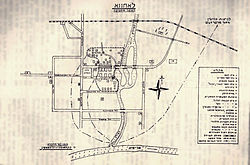Lakhva Ghetto
| Łachwa Ghetto | |
|---|---|
| Transit ghetto | |
|
Łachwa location east of Brześć Ghetto and Sobibór extermination camp during World War II
Łachwa Ghetto map
|
|
| Coordinates | 52°13′N 27°6′E / 52.217°N 27.100°ECoordinates: 52°13′N 27°6′E / 52.217°N 27.100°E |
| Known for | The Holocaust in Poland |
Łachwa (or Lakhva) Ghetto was a World War II ghetto created by Nazi Germany on 1 April 1942 in the town of Łachwa in occupied eastern Poland (now Lakhva, Belarus), with the aim of persecution, terror and exploitation of the local Jews. The ghetto existed only until September 1942. It was the location of one of the first, and possibly the first,Jewish ghetto uprising following the Nazi–Soviet Invasion of Poland.
The town was granted municipal charter by the Radziwiłł princes in 1608. The first Jews settled in Łachwa, Poland, after the Khmelnytsky Uprising (1648-1650). In 1795 there were 157 tax-paying Jewish citizens in Łachwa; already a majority of its inhabitants. Main sources of income were trade in agricultural products and in fishing, expanded into meat and wax production, tailoring, and transportation services. Several decades after the Partitions of Poland by Russia, Prussia and Austria, the railway line Vilna-Luninets-Rivne (Wilno-Łuniniec-Równe) extended to Lakhva, helping local economies withstand the downturn. In 1897 there were 1,057 Jews in the town.
After the reconstitution of sovereign Poland in 1918, Łachwa became part of the Polesie Voivodeship in the Kresy macroregion. Jewish cultural life flourished. There was a well stocked library, political parties and zionist organizations; the Tarbut school of Hebrew learning, and the live-theater association. Łachwa population was 33 percent Jewish in 1921. Eliezer Lichtenstein was the last Rabi before the Soviet invasion of Poland in 1939.
...
Wikipedia



